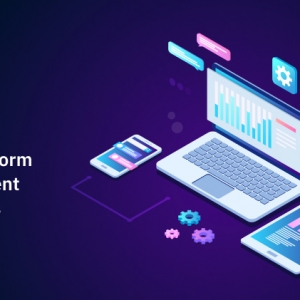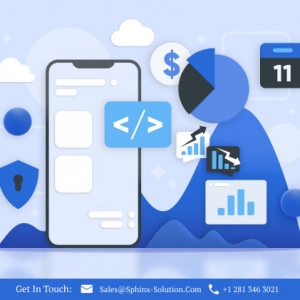In today’s market, Java is a well-known popular programming language because of its features, functionalities, and advantages. Once you plan to use Java for your project, you have to choose which GUI (graphical user interface) framework is suitable to use. Fortunately, Java has a number of frameworks and by using the best GUI frameworks, you can efficiently build better applications.
When delving into frontend development for Java Graphical User Interfaces (GUIs), developers have a plethora of options to choose from among the top Java GUI frameworks. These frameworks play a crucial role in simplifying the process of creating user-friendly, intuitive, and visually appealing applications. In this blog, we will explore the significance of these frameworks in the context of mobile application development, shedding light on their features and advantages. Let's embark on this exploration together.
Why Java GUI Frameworks?
Java is one of the important choices for web app development. This is mostly known for its portability, robust library ecosystem, and cross-platform compatibility. However, developing a unique user interface from scratch is quite a time-consuming and complex task.
Fortunately, the Java GUI framework simplifies the process simplified by offering pre-built components, layout managers, and event-handling mechanisms. This allows Java GUI designers and developers to concentrate on design and functionality. Also when it comes to streaming apps, Java's versatility becomes particularly advantageous. Some of the major benefits of Java GUI frameworks include:
- Cross-platform Compatibility: Java’s compatibility feature extends to the GUI framework. Applications designed with this framework can seamlessly run on multiple operating systems without major modifications.
- Rapid Development: Java GUI framework comes with a wide variety of pre-built components that reduce the time required for developing & customizing UI elements such as text fields, buttons, menus, and so on.
- Event Handling: Java GUI frameworks provide effective event-handling mechanisms that enable professional mobile app developers to promptly respond to user interactions, such as mouse movements, button clicks, etc.
- Layout Management: These frameworks can simplify the alignment and arrangement of the UI components on application windows. This effectively ensures a professional and consistent appearance of your desktop application.
What to Consider Before Selecting Java GUI Frameworks?
Every organization has several considerations to keep in mind when choosing a Java GUI framework to develop rich graphical components. Here are some of the most significant factors to consider before choosing Java GUI Frameworks.
- Your Product Type: Before you start your GUI development process, you need to consider which type of product you need to create. It can be an Android application, a web app, or an IoT application.
- APIs: Does your app communicate with more APIs? If yes, you have to ensure the framework you select can interact with APIs. You should also focus on the API requirements.
- Platform Compatibility: You must ensure the framework is compatible with any platforms such as macOS, Windows, Linux, etc.
- Maintainability & Scalability: Focus on long-term maintainability and scalability of your scalability. A good framework always makes your codebase highly maintainable as your project expands.
- Mobile Compatibility: If you would like to extend your app to mobile responsive platforms, you need to choose a framework that can support custom mobile app development effectively.
What are The Top Java GUI Frameworks?
Usually, the choice of a Java framework depends on the specific project needs and requirements. Some of the best frameworks include:
1. Java Swing
Java Swing is one of the popular GUI frameworks that is part of Java Foundation Classes & offers a set of components for setting up web applications. Swing is known for its lightweight architecture that is extremely suitable for responsive and smooth interfaces. This makes it ideal for a diverse range of applications, from easy-to-use tools to advanced business software systems.
Key Features of Swing:
- Several customizable UI components like tables, buttons, labels, and more
- Pluggable look & feel support to change the UI appearance
- Event handling with the event listeners & ActionListener interface
- Layout managers for accurate control over the UI element’s positioning
- Excellent support for accessibility & internationalization
- Third-party extensions & libraries and are available for improving functionality
2. JavaFX
Built by Oracle, JavaFX is another widely-used Java GUI framework that was designed as an alternative to Swing. JavaFX is mostly used for multimedia integration and modern UI development. High flexibility and a rich set of features have made this framework a perfect choice for developing highly interactive and visually stunning applications.
Key Features of JavaFX:
- Scene Graph: JavaFX utilizes a scene graph that represents the visual elements. This enables complex 2D & 3D graphics rendering.
- CSS Support: Developers can easily apply CSS or cascading style sheets to effectively customize the appearance of JavaFX applications.
- FXML: A markup language that makes UI design simplified and effective by enabling developers to define the user interface with the help of XML syntax.
- Multimedia Integration: JavaFX usually supports animations, audio, video, etc. This makes it a very suitable choice for multimedia-based applications.
- Set of Controls: The JavaFX framework offers comprehensive libraries of UI controls. This includes media players, charts, and tables.
- Scene Builder: This feature of JavaFX offers a very intuitive and user-friendly visual layout tool that helps to design advanced applications.
Looking for The Best App Development Services?
With custom app development, we help brands deliver cutting-edge digital solutions.
3. Java AWT
AWT stands for Abstract Window Toolkit which is an old Java GUI framework. The components of Java AWT are native and lightweight. This means it uses the native GUI components of the platform for rendering. AWT framework is ideal for developing lightweight and simple user interfaces & this is widely used in combination with JavaFX and Swing for complex applications.
Key Features of Java AWT
- Lightweight Components: Java AWT components are extremely lightweight & they use the resources of the native platform. This makes them efficient for user-friendly interfaces.
- Platform Independence: Java AWT components can adapt to the host look & feel of the platform.
- Accessibility Support: AWT framework offers accessibility support for users with disabilities.
- Easy Layout Managers: AWT mainly includes easy layout managers like FlowLayout & BorderLayout to arrange components.
4. SWT
SWT refers to Standard Widget Toolkit which is a popular GUI framework developed by the Eclipse Foundation. Unlike JavaFX or Swing, SWT utilizes native components for rendering. This results in a native look & feel. Moreover, this GUI framework is extensively used for creating Eclipse-centric applications. However, it can easily be employed for standalone applications.
Key Features of SWT
- Native Look & Feel: SWT components resemble the native user interface components of the host operating system.
- Efficient & Lightweight: The use of native components of SWT makes this framework very efficient and lightweight.
- Access to Native Libraries: Developers can access platform-specific libraries and features through SWT.
- Rich Widget Library: The SWT framework offers a comprehensive range of controls and widgets.
5. LibGDX
While JavaFX, Swing, AWT, & SWT are widely used for desktop applications, LibGDX is a Java-oriented game development framework that is used for both mobile and desktop game development. It provides a vast range of features and tools to create 2D & 3D games as well as interactive applications.
Key Features of LibGDX
- Cross-platform Support: LibGDX-based applications can easily be deployed on the web, desktop, Android & iOS.
- Advanced Graphics: LibGDX usually supports OpenGL for top-quality 2D & 3D graphics rendering.
- Input Handling: LibGDX framework gives robust input handling for smooth game development, including gesture & touch support.
- Audio Support: LibGDX provides audio support including audio APIs for sound effects and music.
- Ecosystem & Community: The LibGDX framework has a rich ecosystem & an active community of tools and extensions.
6. Grails
Grails is a popular open-source framework that utilizes Java Virtual Machine to develop web applications. Grails is developed on Spring Boot which means experts have access to a set of unique features. Moreover, Grails is also an ideal option for developing RESTful web applications.
Key Features of Grails
- Best choice for developers who want Groovy instead of Java
- This framework includes easy object mapping
- Code can easily be reused in Grails applications by using an easy-to-use plug-in
- It has dynamic tag libraries for developing web components
- Grails offers a built-in testing framework
- Grails is customizable and it offers extensible Ajax support
- This framework allows seamless Java integration
Want to Hire Professional App Developers?
We deliver end-to-end app development services tailored to your specific business needs.
Final Words
Java GUIs play a big role in making mobile and web application development simplified. Whether you are creating a multimedia-rich interface or a business application, Java GUI frameworks will meet all your needs. The choice of a GUI framework mostly depends on the project’s needs, the application’s complexity levels, targeted platforms, etc. By choosing the right framework, you can make your developer’s team’s tasks simple and help them build robust interfaces seamlessly.
FAQ’s
What is the best framework for Java GUI?
The choice of the best framework for Java GUI mostly depends on your specific project requirements, personal preferences, and project goals. There are too many Java GUI frameworks available and each of them comes with its own strengths and characteristics. Some of the best frameworks for Java GUI development include:
- Swing
- JavaFX
- Java SWT
- Java AWT
- Java Web Frameworks
What are GUI frameworks in Java?
GUI refers to graphical user interface frameworks that usually facilitate the graphical interface development process for Java applications. These frameworks usually offer a number of pre-built components, tools, and methods to develop user-friendly graphical applications for web and desktops.
What are the 6 GUI components in Java?
There are so many GUI components in Java that you can utilize to create graphical user interfaces. Here are the six most widely used GUI components in Java Swing:
- JFrame
- JPanel
- JButton
- JLabel
- JTextField
- JTextField






